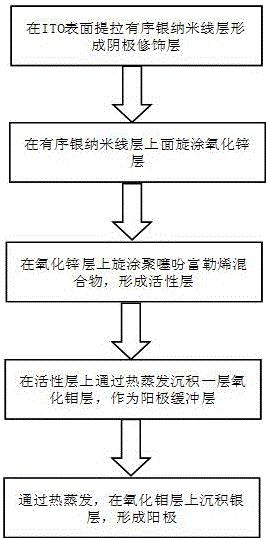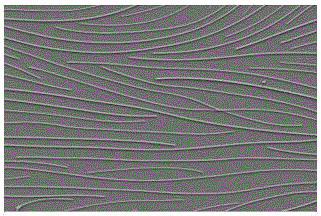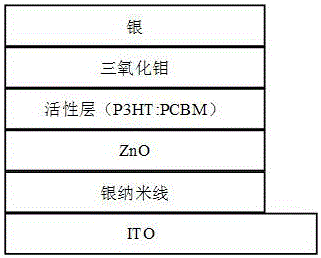Inverted polymer solar cell with silver nanowire/ZnO laminated layer as electronic collection layer and manufacturing method thereof
An electron collection layer and silver nanowire technology, which is applied in semiconductor/solid-state device manufacturing, circuits, photovoltaic power generation, etc., can solve the problems of device overall performance degradation, poor chemical stability, etc., achieve low surface roughness, and enhance absorption capacity , solve the effect of accumulation
- Summary
- Abstract
- Description
- Claims
- Application Information
AI Technical Summary
Problems solved by technology
Method used
Image
Examples
Embodiment 1
[0032] (1) 20 mg polythiophene and 16 mg fullerene were weighed and dissolved in 1 ml dichlorobenzene according to a mass ratio of 1:0.8, and 20 ul DIO was added. The dissolution process was carried out in a nitrogen-filled glove box , put the solution on a hot stage at 50°C and stir for 12 hours;
[0033] (2) Disperse silver nano-solutions with a mass fraction of 0.1% corresponding to silver nanowires with a diameter of 30 nm in isopropanol, the volume ratio of silver nano-solutions to isopropanol is 1:7, and filter with a microporous membrane Carrying out vacuum filtration to obtain a silver nanowire dispersion that is uniformly dispersed and has no obvious agglomeration;
[0034] (3) Carry out the following steps to clean the glass substrate in sequence: ultrasonication of acetone for 10 minutes, ultrasonication of deionized water for 10 minutes, ultrasonication of isopropanol for 10 minutes, and dry before use;
[0035] (4) Using the water bath method, heat 45ml of ultrap...
Embodiment 2
[0043](1) 20 mg polythiophene and 20 mg fullerene were weighed and dissolved in 1 ml dichlorobenzene according to the mass ratio of 1:1, and 20 ul DIO was added. The dissolution process was carried out in a glove box filled with nitrogen, The solution was placed on a hot stage at 50°C with stirring and heating for 12 hours;
[0044] (2) Disperse the silver nano-solution with a mass fraction of 0.1% corresponding to silver nanowires with a diameter of 60 nm in isopropanol, the volume ratio of silver nano-solution and isopropanol is 1:7, and filter with a microporous membrane Carrying out vacuum filtration to obtain a silver nanowire dispersion that is uniformly dispersed and has no obvious agglomeration;
[0045] (3) Carry out the following steps to clean the glass substrate in sequence: ultrasonication of acetone for 10 minutes, ultrasonication of deionized water for 10 minutes, ultrasonication of isopropanol for 10 minutes, and dry before use;
[0046] (4) Using the water ba...
Embodiment 3
[0053] (1) 24 mg polythiophene and 20 mg fullerene were weighed and dissolved in 1 ml dichlorobenzene according to a mass ratio of 1.2:1, and 20 ul DIO was added. The dissolution process was carried out in a nitrogen-filled glove box. The solution was placed on a hot stage at 50°C with stirring and heating for 12 hours;
[0054] (2) Disperse the silver nano-solution with a mass fraction of 0.1% corresponding to silver nanowires with a diameter of 25 nm in isopropanol, the volume ratio of silver nano-solution and isopropanol is 1:7, and filter with a microporous membrane Carrying out vacuum filtration to obtain a silver nanowire dispersion that is uniformly dispersed and has no obvious agglomeration;
[0055] (3) Carry out the following steps to clean the glass substrate in sequence: ultrasonication of acetone for 10 minutes, ultrasonication of deionized water for 10 minutes, ultrasonication of isopropanol for 10 minutes, and dry before use;
[0056] (4) Using the water bath m...
PUM
| Property | Measurement | Unit |
|---|---|---|
| Diameter | aaaaa | aaaaa |
| Thickness | aaaaa | aaaaa |
| Thickness | aaaaa | aaaaa |
Abstract
Description
Claims
Application Information
 Login to View More
Login to View More - R&D
- Intellectual Property
- Life Sciences
- Materials
- Tech Scout
- Unparalleled Data Quality
- Higher Quality Content
- 60% Fewer Hallucinations
Browse by: Latest US Patents, China's latest patents, Technical Efficacy Thesaurus, Application Domain, Technology Topic, Popular Technical Reports.
© 2025 PatSnap. All rights reserved.Legal|Privacy policy|Modern Slavery Act Transparency Statement|Sitemap|About US| Contact US: help@patsnap.com



